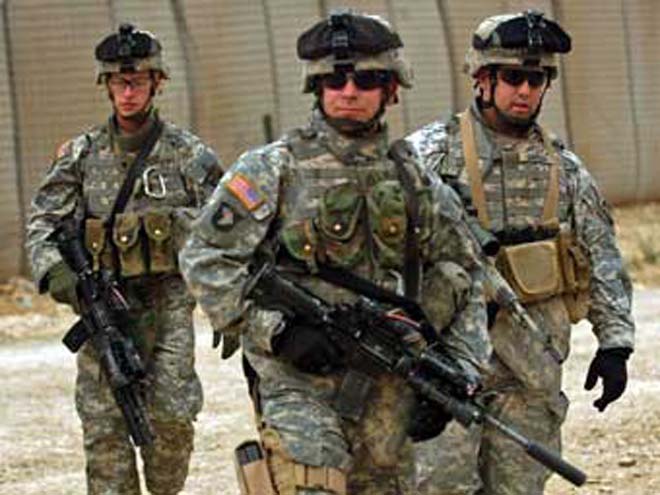Thousands of Afghan forces and US Marines entered the Taliban's main stronghold in southern Afghanistan this weekend as they started their biggest-ever operation against insurgents in the country, officials said Saturday, dpa reported.
Nearly 5,000 US Marines and approximately 2,000 members of Afghaninstan's military forces entered the farmlands and the main city of Marjah, a Taliban redoubt in Helmand province, after midnight Saturday, US Marine spokesman Captain Abraham Sipe said.
The combined forces encountered "minimal resistance" as they were inserted by dozens of armoured vehicles and around 60 helicopter into the Taliban stronghold and the country's main opium-producing region, he said.
"There have been sporadic resistances," General Abdul Rahim Wardak, Afghan defence minister, told a press conference in Kabul on Saturday afternoon. He said their forces were advancing as "planned."
Wardak said that the operation was the first of its kind to be led by Afghan forces and that there were more indigenous than NATO troops taking part in face-to-face fighting with the Taliban in the ongoing offensive.
The joint forces killed 20 Taliban insurgents and detained a dozen other in the operation, General Shir Mohammad Zazai, an army commander in province said. Daoud Ahmadi, a spokesman for the Helmand's governor, said that the joint forces cleared 13 locations early Saturday.
A total of 15,000 troops, including US, Afghan, British, Canadian, Danish and Estonian personnel were mobilized for the operation, dubbed Mushtarak, a Dari word for "together." It is the largest offensive since the US-led coalition invaded Afghanistan in October 2001.
"Marjah is the last enemy sanctuary in the Marine area of operations," Brigadier General Larry Nicholson said in a statement.
"This operation is designed to reconnect the people of Marjah with the legitimate government of Afghanistan. We are fully partnered with the Afghan government for this operation, and we have the resources we need to be successful," he said.
Hours after the operation began, thousands of British and Afghan forces moved around Nad Ali, another district in central Helmand targeted by the offensive, a NATO military spokesman in Kabul said. Up to 4,000 British troops were to take part in the operation.
The spokesman said several smaller-scale operations had been conducted in previous days before the "clearing" phase of the operation on Saturday.
The operation is the first since December, when US President Barack Obama increased the US troop commitment by another 30,000 troops, bringing the US presence to 98,000 soldiers in an effort to reverse gains by the Taliban.
The US and NATO together have around 113,000 troops in the country, and some NATO countries have pledged to send up to 7,000 more troops by this summer. With the new US and NATO forces, there will be around 150,000 international troops in Afghanistan by the summer.
The offensive aims to extend the Afghan government's authority in the region, ISAF officials said.
Contrary to usual military doctrine, the ISAF leaders publicly announced the operation well in advance so as to warn the Afghan population.
President Hamid Karzai called on the combined forces Saturday to "to exercise absolute caution to avoid harming civilians" and "consult the local people, fully coordinate their actions and to avoid using air power in areas where civilians can be at risk," the president's office said in a statement.
On Friday, NATO airplanes dropped leaflets warning people not to give shelter to the Taliban, and to stay away from Taliban positions inside the Marjah district, said Ahmadi.
Days prior to the operation, hundreds of residents of Marjah left the district for Lashkargah, the provincial capital, located some 30 kilometres to the east. Some 200 families also left Nad Ali and the surrounding areas.
But locals said that most of the 80,000 population have stayed put, because they could not afford to move out of the area or did not want to leave everything behind.
The publicity about the operation has also given Taliban fighters more of a chance to plant additional roadside bombs, a common tactic of the insurgents, which has proved to be the deadliest for NATO troops in the past three years.
Marines spokesman Sipe said roadside explosives were the main concern for the combined forces, but so far they have not "slowed down their advances significantly."
"They have mined heavily and also booby trapped (the area), so we have to be slow in the process of clearing the area," Wardak said Saturday.
Wardak said many of the Taliban fighters had left before the operation started, adding: "Based on our intelligence from the area, some of them have already left, but there was an expectation of several hundreds still in the area."
"As of yesterday we received some reports that there have been some reinforcements from adjacent provinces," he said.
But, Taliban spokesmen have said that they had 2,000 fighters in the district and they were fully prepared to defend the area. Locals also said that the Taliban announced in mosques that they had enough weapons to distribute among the local villagers.
Taliban spokesman, Qari Mohammad Yousif Ahmadi, speaking from an undisclosed location, said Saturday that Taliban fighters repelled the NATO's morning onslaught and inflicted heavy casualties on US soldiers.
Marjah shares a long border with Pakistan, where the Taliban are said to have rear bases and training camps. The district also borders the conflict-ridden Afghan province of Uruzgan.
NATO's major Afghan offensive begins in Helmand
Thousands of Afghan forces and US Marines entered the Taliban's main stronghold in southern Afghanistan this weekend as they started their biggest-ever operation against insurgents in the country, officials said Saturday.






